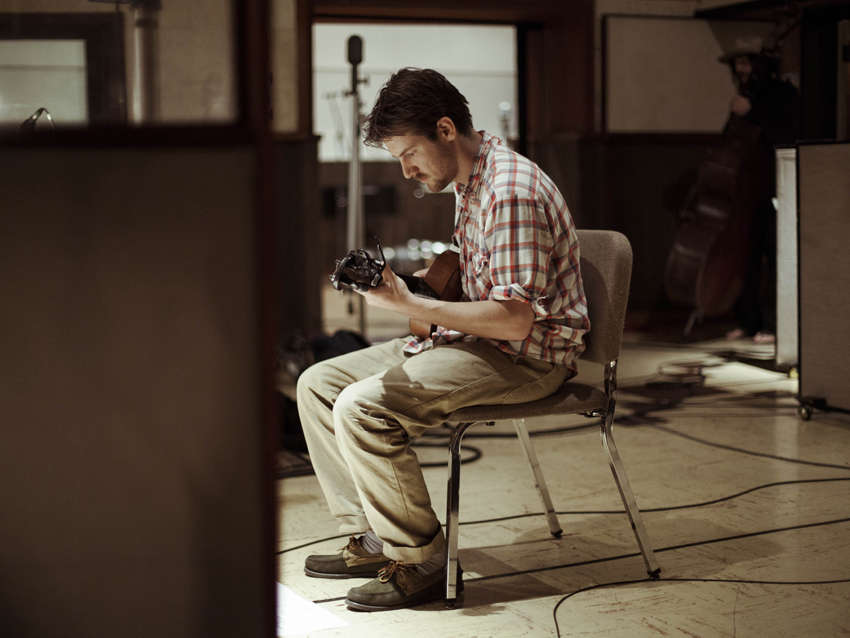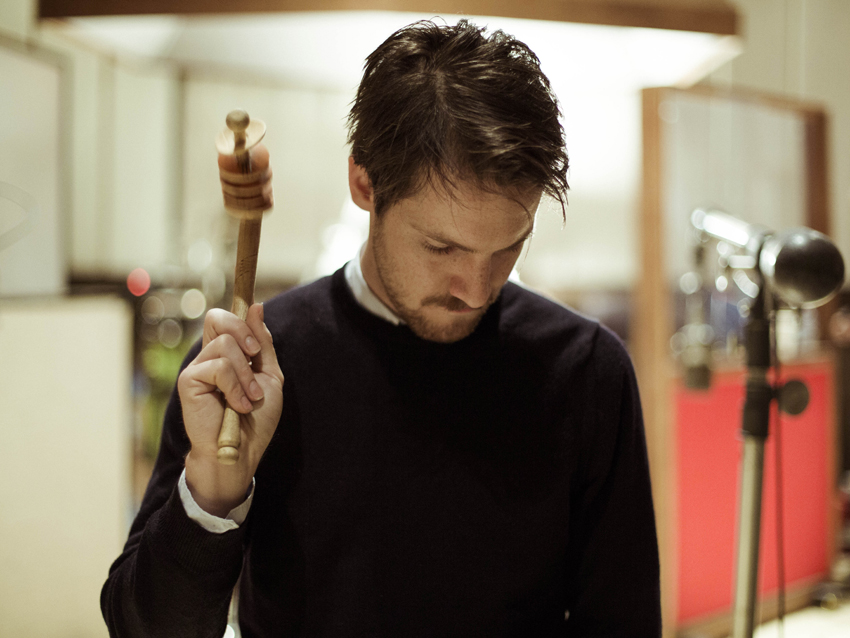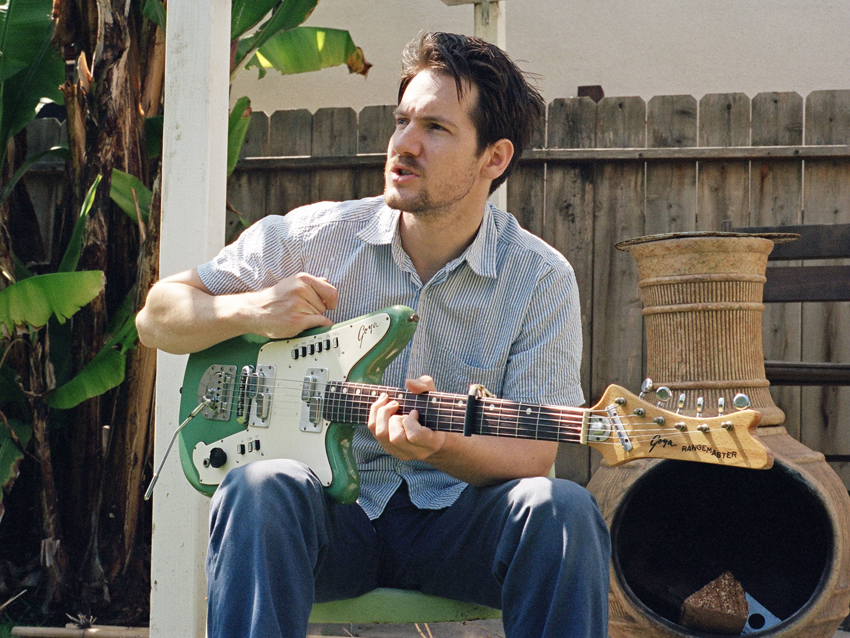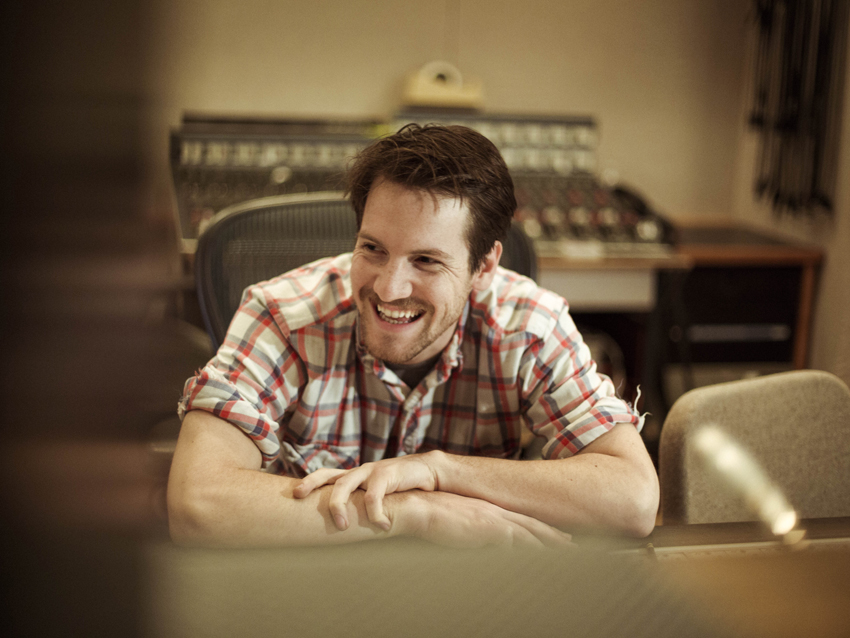
Blake Mills: the modern session king becomes a solo star
Blake Mills' songs get under your skin with a hushed, gentle intimacy that can feel disarming and soothing. Part of that's in the writing – his compositions unfold at an unhurried, almost peripatetic pace. Some of it's due to his rich and understated virtuosic guitar playing – he doesn't go in for the fast burn; rather, he dances and converses with melodies and moods in a way that is reminiscent of Mark Knopfler. And then there's that voice: On Heigh Ho, his recently released second album, Mills lets you in on feelings as if he's whispering secrets right in your ear.
And so it comes as almost no surprise, then, when Mills says that most of his vocals were recorded in the confines of his car, parked at beaches and in state parks, with a mic and a laptop, usually during the hours of two or three in the morning for maximum introspection. "I just felt really secure in that environment," he says with a laugh. "I could experiment and not worry that I was being listened to. I mean, who doesn't sing in their car, right? And because of that, I found that I was maybe getting at some sort of truth because I was so familiar with the sound of my voice in the car. It felt natural and familiar to me, but I guess kind of different, too."
Since leaving the band Simon Dawes (which soon became simply Dawes) in 2007, Mills has become a hot commodity both in the studio and on stage, with everyone from Kid Rock and Jeff Bridges to Lucinda Williams and Fiona Apple calling upon him to lend his elegant and highly idiosyncratic guitar playing to their music. He could quite easily stake his claim right there and enjoy a sort of post-Wrecking Crew/The Section-like career, but the 27-year-old, whose musicianship and insights bear the maturity of someone twice his age, comes into his own on Heigh Ho.
When he wasn't singing in his car, Mills set up shop at Hollywood's famed Ocean Way Studios with a dynamite rhythm section trio – Don Was and Mike Elizondo handled bass duties, and drumming legend Jim Keltner laid down his distinctive groove – along with a glittering array of guests such as Benmont Tench, Fiona Apple and Jon Brion, among others. The resulting 12 tracks shift effortlessly between moods and genres – for dreamy, there's the exquisite country-tinged Seven, and for a Cubano-inspired turn, there's Three Weeks In Havana – but the constant thread throughout is Mills' poignant and inquisitive assessment of human and romantic relationships.
Mills sat down with MusicRadar to talk about the recording of Heigh Ho, his love of Telecasters (particularly his main axe, a '52 stunner that might be permanent loan from Jackson Browne), and what it was like to share the stage with Slowhand. (Blake Mills' Heigh Ho can be purchased on iTunes or at Amazon.)
Listening to your music, I'm reminded of Brian Wilson's I Just Wasn't Made For These Times. It feels like your music stretches back to the past, even though it's in every way au courant.
[Laughs] “Yeah, that's a great lyric, isn't it? Well, you know, that's interesting. It seems to me, I think, that the goal to a lot of record production these days is about landing a song on a car commercial or some kind of TV spot. You put on a record and it’s really exciting for 30 seconds, but sustaining that is hard. There’s no dynamic approach. Maybe that’s because people are only trying to write the most interesting sounding 30 seconds they can, which means that they aren’t writing a good full song.
“I’m trying to sustain the level of interest a little longer. I want to transport the listener for an entire album, or in my live show for an hour, hour and a half. You have to play with dynamics and intensity if you’re going the distance. I’m definitely interested in moods and details, letting things unfold."
I want to talk about your singing. On so many tracks, but particularly on If I’m Unworthy, there's such a beautifully vulnerable and emotive quality to your voice.
“Thanks. That's a nice compliment. See, I fell in love with Nina Simone, just as a general musician, by the time I was 13 years old. I don’t have an instrument like that, and I can’t play like she can. She’s, like, the high priestess of soul. But yeah, I have fallen in love with really emotive singers, and I do appreciate, what you said, the vulnerability in people’s voices. It’s always easier to fall in love with that aspect of somebody else’s performance than it is to come around on it when it’s your own vulnerability. It’s always better to watch somebody else make a fool of themselves.” [Laughs]
You’ve been a sideman for a lot of great folks. Did you originally want to be more of a session guitarist?
“Well, I’ve really loved doing sessions, and I still do. I feel as though I learned a lot as a musician – and just how to be a more agreeable person – by doing sessions. When I was in a band, it was based around the idea of co-writing and representing your artistic statement in everything that you do, from your fliers to your artwork to so much other bullshit. You add so much more importance to that sort of thing when you’re 16 years old and you’re making your first record.
“But when I was doing sessions, they weren’t cold and soulless at all. I was playing with these incredible musicians right out of the gate. Whether it was the producer or the songwriter, it was clear who needed to be happy. And all the gigs were great – I got so much out of every experience. I’ll continue to do sessions. If I can drop what I’m doing and participate in cutting tracks with other people, I’ll do it. It’s really rewarding.”
NEXT: Moving beyond grunge and metal

Moving beyond grunge and metal
You began playing guitar because you were enthralled with Nirvana and Metallica. But then you started to branch out. I hear so many people in your style – Ry Cooder, Lindsey Buckingham, Mark Knopfler…
“That’s right. I think what happened was, I started to fall in love with music that wasn’t based around the guitar. I became more fascinated by the quality of the voice and other instruments. At the same time, I had enough of a grasp on the guitar that I could get it to sound like those instruments. It was like a Rosetta Stone for all of these other sounds I was hearing – I could reproduce or imitate them on the guitar rather than picking up something else.
“I became a big fan of Derek Trucks’ playing, and in reading about him I found that he wasn’t so focused on the pantheon of guitar players as much as he was other instrumentalists, as well. He was coming from a gospel and soul side simultaneously with a Middle Eastern influence, and I thought, ‘Finally, here’s a musician who is showing me that these influences don’t have to be partitioned off.’ I don’t have to keep what I love about Rolling Stones records away from what I love about some other things. It’s a cliché, but the universality of music is still very apparent. The inspiration that got me to fall in love with electric guitar still carried through, but I just realized there was more out there.”
A lot of younger players don’t get that right away. They get locked into a mindset of achieving virtuosity without thinking about musicality.
“Yeah. I think you could argue that some of that’s in the tradition of Western music and classical music. There’s plenty of examples of the sliding scale of what’s really impressive and what’s really moving emotionally. The guitar seems to have enjoyed this celebration as being the celebrity instrument of the ‘60s and ‘70s. I was having this conversation with somebody about how there’s that question: ‘Who’s the greatest guitar player in the world?’ That just turns the art of playing guitar, something that’s supposed to be creative and expressive and personal and unique, into an almost athletic feat.
“As soon as I started taking lessons from somebody who showed me a lot of the sweep picking and the Yngwie Malmsteen and Steve Vai stuff, I realized that it wasn’t difficult if you put the time into it. It also becomes less impressive and mysterious. What’s really powerful and mysterious and magical is ‘How the hell did Elmore James get that tone?’ All of that stuff where you can’t figure out where it came from – that’s what fascinates me. And more than ‘how?’ it’s ‘why?’ Why was he doing that?”
NEXT: In love with slide

In love with slide
What kind of musical vibe did you get from recording at Ocean Way?
“The decision to record in Studio B of Ocean Way came from a session I did in that room with Jim Keltner. It was for the Carlene Carter record. Don Was was producing, Jim was on drums, Greg Weisz was on guitar – a bunch of great people. The sound of the room, coupled with what Jim does – and I heard this mostly between takes, when we were jamming – was amazing. I felt like I was in a movie, or like I was inside of these records that I’d heard all my life.
“I made it a point to record there. We booked a couple of weeks and tracked most of the record as a trio, with either Don Was or Mike Elizondo playing bass and Jim on drums. It’s a different experience walking into a room like that, especially if you’ve listened to a lot of records that were done there. That was really the default way of making records – before the experimental side of things and The Beatles and psychedelia, you had no choice but to capture some version of the environment. Everything sounds different in that room. You walk around, you whistle, you make a noise – it all makes a sound that you want to hear all day long.”
You get a huge Peter Green-ish wave of lines on Just Out of View. The reverb is kind of the star of the sound. Are you playing your Tele on that one?
“No, that’s the Goya Rangemaster. That’s an interesting guiyar. It’s got these split pickups. The wound strings and the plain strings each have their own pickup, but there’s two sets. It has these electro-mechanical switches you push down to get different combinations of sounds. There’s a killswitch on it, though, so if you push it down halfway you only turn off half of the setting, so you’re essentially left with three strings that work and three that don’t. If you’re playing the strings that don’t, you get these overtones on the open strings that are being picked up. It’s pretty cool. You get these, like, chimes, but the reverb is tuned to whatever the strings are tuned to. It’s just a really interesting thing about that guitar.”
Seven has these great fingerpicked, plucked dirty chords. What an amp sound! It sounds like it’s breaking up.
“It is. It’s breaking up quite a bit, but there’s a lot of filtering going on to decimate the high end. The tone on the amp is way up so you have brightness, but the tone knob on the guitar is rolled back. The main guitar is one that a friend of mine built for me. It’s similar to a Coodercaster, but the pickups are wired out of phase – in the middle position, they’re out of phase. That’s why the main guitar on that track has sort of a squawk to it.”
I love the slide guitar playing on Don’t Tell Our Friends About Me.
“Yeah, that’s like two guitars conversing. I’ve always been a big fan of George Harrison’s slide playing. He was like a poet with a slide. He would do these beautiful harmonies, almost orchestral voicings. It wasn’t just simple parallel voicings; there was always some beautiful musicality in that. I sort of started there and worked my way into something that is almost like a duet, like the way that Fiona and Johnny Cash did their duets, the way she would weave in and our of what he sang.”
NEXT: On borrowing Jackson Browne's Tele

On borrowing Jackson Browne's Tele
Let me ask you about your main guitar, the ’52 Telecaster that you got from Jackson Browne.
“That guitar's so amazing. I was at his studio and we were playing guitar, and I was sort of waxing about Telecasters, how I just think they’re the perfect guitars. So he had this Tele that was sort of the quintessential one – I was playing it and just couldn’t put it down. After a while, he said, ‘Well, why don’t you just borrow it for a little bit?’ We went back and forth with me refusing, but he finally said, ‘Just hang on to it till you come across a better one.’
And you still have it!
[Laughs] “Yeah, I’ve been playing it for maybe three years. I don’t know when he’s getting it back. But I let him borrow one of mine at the same time, so there you go. Still, what can you do? When a musician gets a chance to play a Stradivarius, it’s not like a loan – it’s almost a grant. He’s bequeathed this guitar to me. I’m just trying to make music on it the best I can and take care of it. It’s a special guitar, and I feel a certain obligation to doing good things with it.”
A lot of great guitar players have a hard time writing songs. Does songwriting come easily to you?
“No, it doesn’t. It’s definitely an aspect of music that I have to work at. What comes the easiest is the sitting down and playing and accessing the mood of something. Finding words that hold up can be difficult. I scrutinize lyrics and can be quite hard on myself in that regard. I appreciate well-written lyrics, so it’s a struggle for me to pull words out that I’m really happy with. I’m working at it.”
When you played with Eric Clapton at the Crossroads Festival, were you intimidated at all?
“It wasn’t intimidating, no. When you’re on stage with that many guitar players, it’s kind of like ‘It doesn’t really matter what I do here.’ I just kind of laid back and enjoyed the front-row seat. It was a little like when you’re at a table and there’s a discussion going on between lots of people. If you’re not the host, you don’t have any responsibility to keep the conversation going; you can just listen and follow along. If you have something to add, you wait and pick your moment. If you can do that, you’re more a part of the conversation than if you threw some boneheaded comment in there.” [Laughs]
Last question: When you work with Jim Keltner, do you have to stop yourself from pumping him with questions about all the greats he’s played with?
“You know what? You don’t have to pump him with questions – he just goes. And I’ve never heard him repeat a story. It’s remarkable. He’s not one of those people who lives in the past, either. He’s a forward thinker. He loves to play, and he does it every day, even in his 70s. He’s got a session every day. He’s a remarkable and beautiful human being, a life giver.”
Joe is a freelance journalist who has, over the past few decades, interviewed hundreds of guitarists for Guitar World, Guitar Player, MusicRadar and Classic Rock. He is also a former editor of Guitar World, contributing writer for Guitar Aficionado and VP of A&R for Island Records. He’s an enthusiastic guitarist, but he’s nowhere near the likes of the people he interviews. Surprisingly, his skills are more suited to the drums. If you need a drummer for your Beatles tribute band, look him up.
